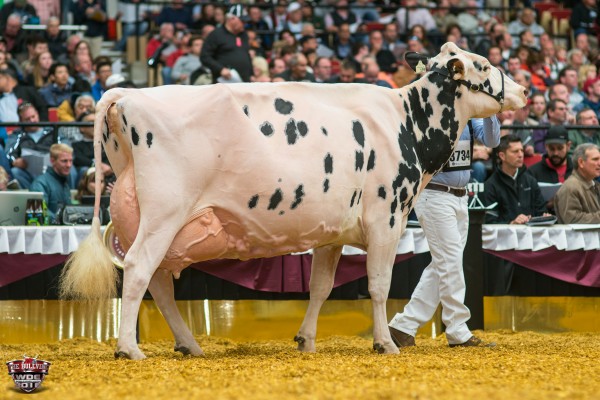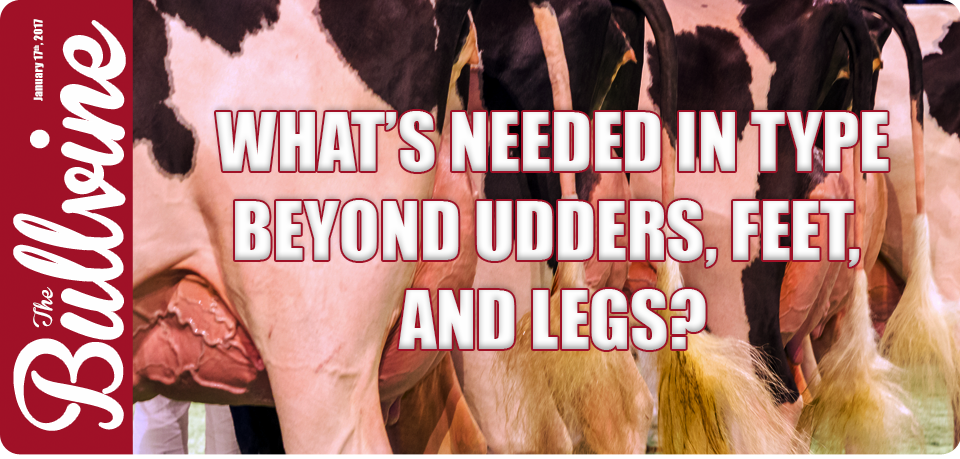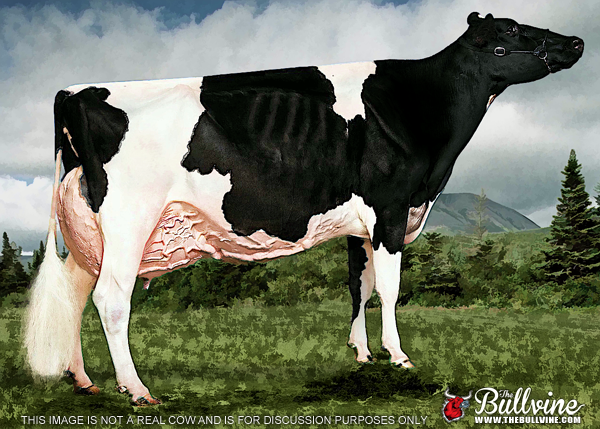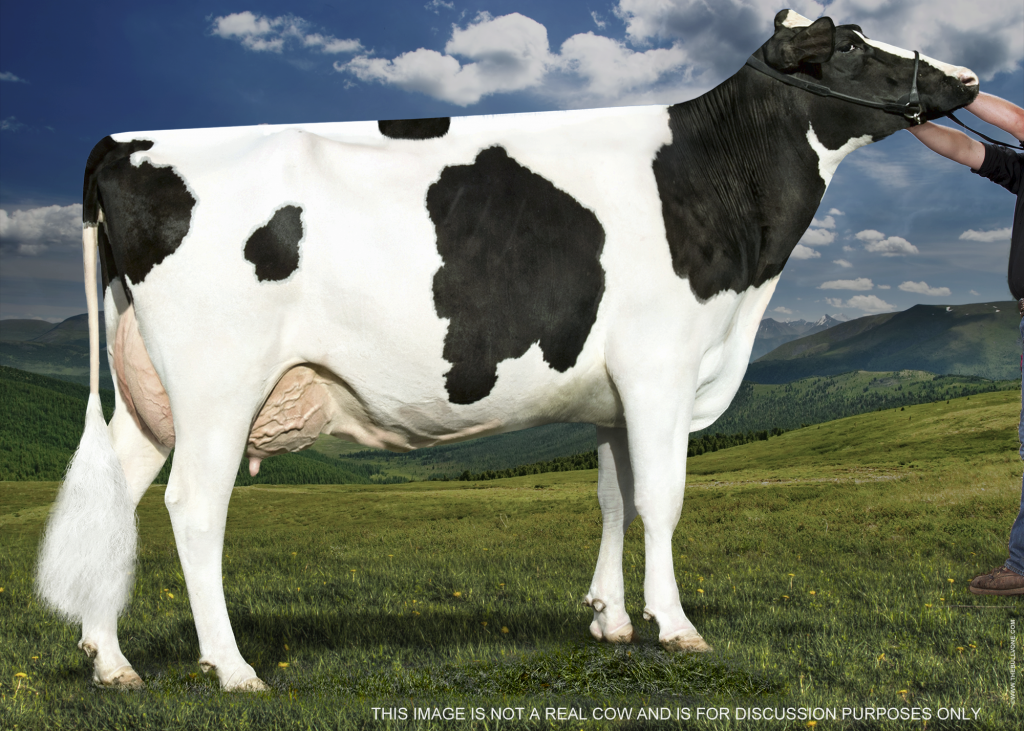I have recently read on Facebook and have heard over the past six months that many breeders and judges want today’s dairy cows to have more strength. Dairy Strength that is. Not pulling or pushing strength.
However, on milk production farms is more dairy strength actually what is needed?
Yes, functional udders, feet, and legs are definitely needed. But, beyond those appendages, do milk producers need any other body type traits improved or changed from what currently exists? And if they need those traits, how do milk producers select for them?
Only 1/3 of Type Scorecard
With Udder, Feet and Legs taking up almost 2/3 of the total points in the dairy cow scorecard that leaves only about 35 points to cover everything else from the muzzle to the tail head. There are already twelve descriptive body or associated functional traits assigned by Canadian classifiers or collected by Canadian milk recording supervisors. Therefore, even for purebred breeders, let alone milk production focused dairymen, there is very little emphasis that can be placed on any single body part.
The Milk Producers Champion Cow
Here at The Bullvine we have produced articles on: a) what the milk producer, who also likes to breed for high genetic merit, needs in his ideal two-year-old (Read more: The Perfect Holstein Cow); and b) what the cows that make the most lifetime profit are like in their first lactations (Read more: She Ain’t Pretty, She Just Milks that Way). Even though we gave our ideal model index cow considerable capacity, our findings when we produced the second article were that extreme capacity was not a must have in first lactation cows.
Every breeder or enthusiast has their favorite cow. And every milk producer can tell you exactly how their very best cow performed in their herd. No doubt everyone has their own Grand Champion in their barn. All these cows have their own strong points from head to tail, and perhaps limitations, but each is still a champion to their owner.
What Do Sire Proofs Tell Us?
CDN has studied the 4310 bulls proven in Canada between 2000 and 2015 and published the correlations between the indexes for all traits. Assuming that all milk producers want long-lived cows, the following are the correlation between the body type traits and herd life (HL). HL is the same trait as PL is in the United States.
Body Traits Positively Associated with Herd Life
Daughter Calving Ability (aka MCE in USA) +0.43
Body Condition Score +0.27
Thurl Placement +0.18
Rump Angle +0.12
Body Traits Negatively Associated with Herd Life
Body Depth -0.28
Angularity -0.12
Pin Width -0.08
Body Traits with About Zero Correlation with Herd Life
Loin Strength +0.04
Chest Width -0.04
Stature 0.00
Height at Front End -0.02
Dairy Strength -0.05
From this study of fifteen years of Canadian proven sires, longevity can only be affected by selecting for daughter calving ability, body condition score and thurl width (aka rump width) and selection against deep bodies. Minor consideration can be given to proper rump angle but against too much angularity. The small negative correlation (-0.08) between pin width and length of herd life will surprise people trained in show ring judging, where it is considered to be a big positive.
Alta Genetics studying US proven sire indexes found that stature sire indexes have a -0.45 correlation with productive life (PL). That compares to a correlation between stature and herd life of 0.00 in the Canadian data. For PTAT and PL sire indexes the correlation is -0.18. All that leading to the conclusion that type traits sire indexes are not good predictors of length of productive life of their daughters.
Think Ideal For Age
Often when dairy people evaluate the body conformation (excluding udders, feet, and legs) of dairy animals, I think we fail to take into consideration age, age at first calving and number of calvings. We overlook /don’t give enough weight to the fact that the breed ideal females are usually mature cows and often younger animal’s body parts are inappropriately compared to those of the ideal.
Like the human race where teenagers, late twenties, and forty-year-olds have different body dimensions, yearlings, first, lactation and mature cows have different widths, depths, heights, and lengths. Therefore breeding for increased stature over the past half century has resulted in animals taking longer to develop total capacity.
For breeders not interested in the show ring, the ideal body structure for heifers is fast growth with good body condition, adequate width, and proper thurl placement. Once calved at 1-10 to 2-00 years they will develop into cows capable of consuming and processing large volumes of their diet. As noted above being concerned about stature, chest width and height at front end should not be a concern in having a herd, where at least half the cows reach their fourth lactation.
Let’s Talk Individual Cows

Huntsdale Shottle Crusade EX-95-3E 2*
2017 Nasco International Type & Production Award Winner at World Dairy Expo
The Bullvine writers have the good fortune to have bred the #1 Lifetime Production Cow, Huntsdale Shottle Crusade, at the 2016 World Dairy Expo. When she left Huntsdale Holsteins as an open yearling, she carried very good body condition, was average for width of body, ran downhill, had a strong loin and shallow body … definitely she was not the EX95 that WDE spectators saw in the ring. Benbie Holsteins have taken that raw heifer and developed her into an outstanding cow. She has gone from a GP84 for body as a first calver (shallow and round ribbed) to EX95 for body as a fifth calver having produced 107,000 kgs (235,000 lbs)of 4.0%F, 3.2%P milk in five lactations
The writer had the good fortune to see Glenridge Citation Roxy EX97, the Queen of the Breed, as a three-year-old at her breeder’s farm in Saskatchewan. At that time her body was slightly shallow with above average width, and she carried very good body condition. I am sure most Holstein enthusiasts will agree that Roxy has earned her queen status from what she accomplished. Over time she developed the width and depth necessary to be a star in the barn and in the progeny she produced.
How To Select the Sires Milk Producers Need to Use
Selecting the top NM$ or Pro$ sires will get the job done 90% of the time. Don’t over complicate sire selection. When it comes to body parts, select the very top NM$ (at least 750 NM$) or Pro$ (at least $2000) Holstein sires and eliminate those below average for maternal calving ease, rump angle, thurl placement, thurl/rump width and body condition score. Definitely avoid Holstein sires that leave deeper rear ribbed daughters. Simply using Dairy Strength or Body Composite is not an accurate predictor for breeding long-lived cows.
The Bullvine Bottom Line
Milk producers want neither cows that are oxen or reindeer. When it comes to body parts, there are only four to five linear body part or associated functional trait indexes that need to be considered. The conformation of today’s dairy cows is in good shape and that allows milk production focused breeders to put their attention, when selecting sires, on production, health, and fertility. Dairy Strength is not a must include when breeding for longevity in milk production herds.
Get original “Bullvine” content sent straight to your email inbox for free.




















Leave a Reply
You must be logged in to post a comment.